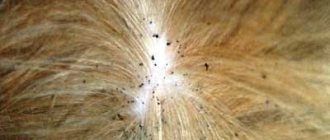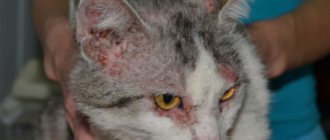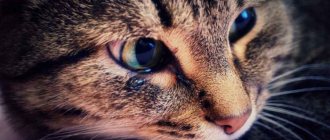I wonder why a cat constantly licks itself and scratches itself. Have you ever asked yourself a similar question? If this happens occasionally, then this is normal. But if you notice that your pet does this too often, you need to become more vigilant.
The skin is the only organ for which the appearance and characteristics are presented in the proverbial palm. It does not take much time to assess the condition of the skin membrane. At the same time, it can provide extensive information not only about itself, but also about the functioning of the entire organism as a whole.
This is a real storehouse of knowledge about the quality of health of our animals, because so far nothing alarming has happened, the skin is also without complaints. However, at the moment when it begins to hurt, you should pay attention to these symptoms, as this may indicate a disruption in the functioning of other organs and systems.
What is itching
One of the most common, most prominent and most annoying symptoms of skin diseases is itching. You need to understand what kind of phenomenon this is and what factors are responsible for its occurrence. Itching is a term used to describe an unpleasant sensation arising from the skin, leading to scratching and rubbing. This is one of the signs of skin diseases, which, however, can be accompanied by other infections.
If we talk about duration, we can highlight:
- Itching is acute (lasting less than six weeks),
- The itching is chronic (lasting more than six weeks).
Short-term itching is a defense mechanism (just like acute pain), indicating that “something is happening” in a given area of the skin. For example, as a result of an insect bite, cats begin to scratch the area to remove the parasite from its surface. Another thing is chronic itching. It may be accompanied by more serious medical conditions.
It is worth noting that the feeling of itching in cats can vary depending on the time of day, skin condition, body temperature or extreme stress. The threshold for the perception of itching decreases (which means the animal becomes more sensitive to irritants) in the following cases:
- At night. During this period, the influence of factors on the body decreases (for example, pain, touch, cold, heat), and therefore the need to itch disappears.
- At elevated skin temperature.
- With reduced skin hydration, dry skin itches more.
- With factors stimulating the mental state, in states of stress. Opioid peptides are then released, which can increase the itching sensation.
Some of the more common symptoms of itching in cats are:
- scratches,
- licking skin and fur,
- gnawing,
- chewing various parts of the body (for example, paws, tail),
- complete or partial hair loss,
- baldness,
- self-harm,
- dermatitis.
These animals are very reserved, which means it is very difficult to guess why the cat is constantly licking itself and scratching itself. Therefore, pay attention to the unusual behavior of your four-legged friend, such as:
- Rolling from side to side,
- Sounds that are more intense than usual
- Shaking your head
- Frequent demands for affection, with the itchiest areas of the body exposed.
If your cat has worms, read the article on how to get rid of them.
[custom_ads_shortcode1]
Main symptoms
Some pathological conditions of the skin, which are accompanied by severe itching, are clinically manifested by redness of the skin at the site of the lesion, loss of elasticity and firmness, as well as scratching from the claws of the animal. Since a sick pet is trying to relieve itself of the discomfort that has arisen, it will constantly scratch and lick the itchy areas of the body.
In places of intense itching, wounds from scratching, areas of baldness, and infected scratches are identified. A cat that is bothered by itching must be shown to a veterinarian, who will conduct a series of studies to determine the nature of the underlying disease and prescribe adequate treatment.
Reasons for constant scratching in cats
As mentioned above, there is a huge list of prerequisites that lead to a cat licking itself intensively. And you don’t need to think that the well-known proverb “to the guests” applies here. This can be a sign of very serious systemic diseases. In many cases, the condition of the skin and its diseases are only the visible cause of a problem hidden deep in the body. It is often very difficult to determine what causes the need to scratch in cats. The most common factors are shown in the table.
| Cause | How it manifests itself |
| Bacterial infections | Changes that accompany infections are:
There may be a characteristic purulent exudate that sticks to hair and envelops the skin in certain places. |
| Fungal | Ringworm in a cat is contagious; it can be picked up through direct contact with a sick animal or its environment (cage, combing brush, etc.). Itching is not a constant symptom of this disease. Clinical manifestations are varied and varied, with varying degrees of alopecia, erythema and scaly formation predominating. The changes are usually located on the face, head, neck and limbs, but it happens that they are also present on the body. |
| Parasites | Mites live in the stratum corneum of the epidermis without penetrating the hair follicle. The disease occurs with severe itching and peeling of the upper areas of the skin. Dandruff appears on her. These parasites are located on areas of the body covered with delicate skin, especially in the vicinity of the eyes, lips, abdomen, external genitalia, legs, head, ears. |
| Allergic street dermatitis | The most unpleasant discomfort and hypersensitivity reaction occurs due to antigens contained in the saliva of fleas. Why does a cat constantly lick itself and scratch itself if it has access to the outdoors? This allergic dermatitis is very difficult to diagnose. Even if you take care of your pet and constantly apply medications that prevent the spread of fleas, the presence of this disease cannot be completely ruled out. |
| Food allergies | Food allergies are a reaction of the immune system to certain proteins contained in food. It appears regardless of age and breed, but Siamese and Burmese cats are more predisposed. Main changes: itching of the facial part of the muzzle, head, neck, symmetrical baldness, dermatitis. In this case, it is better to feed the kitten vegetarian food. |
| Atopy | The disease is congenital, during which a hypersensitivity reaction develops after exposure to some environmental allergen. The main one is house dust mite, the secondary ones are flower pollen, desquamated epidermis, and mold. Additional symptoms may appear: rhinitis, cough, shortness of breath. |
| Increased sensitivity to insect bites | Occurs with the formation of skin changes and swelling of varying degrees of complexity: the ridge of the nose, changes in the sense of smell, ears and around the ears. Symptoms disappear after eliminating mosquitoes from the cat's environment. |
[custom_ads_shortcode2]
Main causes of itching
All causes of itching in cats are divided into several groups.
Ectoparasites
This group includes subcutaneous and cutaneous mites, as well as other blood-sucking parasites. When they appear, dandruff and other flaking appear, hair falls out, and the cat itches until it bleeds.
Severe itching is characteristic of the following diseases:
- Otodectosis. The animal often scratches its ears, face, and shakes its head. As a result of the activity of ear mites, black deposits are noticeable in the shells.
- Sarcoptic mange (pruritic scabies). The cat scratches its neck. If left untreated, the itching moves to the back. Associated symptoms are hair loss at the base of the tail and the appearance of crusts over the body.
- Notoedrosis. The muzzle, back of the head, and brow ridges are susceptible to itching. The animal itches until it bleeds. As a result, the skin becomes rough and thick.
- Cheyletiellosis (wandering scabies). The main symptoms are that the cat itches all the time, and “live dandruff” is noticeable in the tail area. A detailed examination will show that it is not dandruff, but gray skin mites.
- Lice, lice, mites and flea dermatitis. In most cases, fleas and the saliva they secrete are to blame. When infected with them, the cat constantly itches and licks itself. Because of this, hair falls out and bald patches appear.
Allergies
With a food allergy, the cat actively scratches its face and ears, licks and bites its paws. This happens when there is a sudden change in food or the introduction of new foods into the diet. Most often, allergies are caused by insect bites: mosquitoes, wasps, bees, ants.
Interesting! Food allergies in cats often occur when there is a sudden change in food.
Some cat breeds are prone to seasonal allergies. Itching is caused by pollen, house dust, and certain plants. Contact with chemicals and household products also leads to itching and irritation.
Important! Atopic dermatitis cannot be cured. The doctor only prescribes maintenance medications. They reduce symptoms and are given to the animal for the rest of its life.
Contact allergies are a rare type. It occurs when an allergen comes into contact with an animal's skin. As a rule, this is the area of the abdomen and chest. If this type of reaction is suspected, allergy tests are performed.
Skin infections
If your cat is itching but there are no fleas, skin infections may be the cause. They most often join the primary problem. As a result of the activity of bacteria, eczema and weeping wounds develop on the pet's skin. The cat licks them, which causes open wounds.
The development of a fungal disease is indicated by bald areas of the body, peeling and changes in pigmentation. Dermatophytosis manifests itself in individual foci or their connection throughout the body.
Dermatophytosis is characterized by inflammation of the skin in places where it is damaged. These can be insect bites, allergic and neurological wounds. There is redness, swelling or swelling of a certain area on the cat's skin. If an animal scratches its skin vigorously, the temperature of that part of the body rises.
Dry skin
Due to a lack of vitamins A and E in the body, as well as when choosing poor-quality hygiene products, the skin dries out. This process is accompanied by severe itching. First, the cat itches on the sides and back. Then dandruff appears, the skin dries out and cracks in places. The coat does not fall out, but noticeably becomes dull and loses its healthy appearance.
Autoimmune pathologies
Autoimmune pathologies are quite difficult to diagnose and treat. They are characterized by a violation of the body's immune system. As a result, protective cells perceive their own cells and tissues as foreign and attack them.
Important! Discoid lupus erythematosus occurs most often in dogs and is extremely rare in cats.
Such pathological processes are characteristic of diseases:
- Discoid lupus erythematosus. It is characterized by the sudden appearance of wounds and other injuries on the body. In this case, antimicrobial drugs do not give results. Immunosuppressants and glucocorticoids are effective in suppressing this process.
- Jacobs ulcer. This is truly a cat disease. It is characterized by the appearance of a sore on the upper lip of the animal. At first it is a small bubble. Then it turns into an ulcer. If left untreated, teeth and gums become exposed. Antibiotics and wound-healing drugs do not give results.
- Pemphigus foliaceus. The cat itches to the point of sores in the face area. Infections and bacteria often penetrate into scratching areas. This leads to tissue inflammation and the appearance of crusts.
Psychogenic factors
Cats do not tolerate stressful situations well. And at the slightest nervous tension there is a risk of psychogenic itching. The animal begins to chew its tail or itch. In this way the pet calms itself. Soon a dependence on this process arises.
Interesting! Diagnosing psychogenic itch is a complex process. It is determined by excluding other possible causes.
Other reasons
When there are hormonal imbalances, the cat constantly itches and licks. These symptoms are characteristic of the following pathologies.
- Thyroid gland dysfunction. Additionally, hair loss, dullness, dandruff and itching are noted.
- Diabetes. With this disease, cats experience partial hair loss, dullness, dryness, and seborrhea.
- Cushing's syndrome. Improper functioning of the adrenal cortex leads to loss of skin elasticity. Comedones appear on the back and sides.
Cats often itch due to ear infections. Itchy places are the ears, neck and head. With otitis media, discharge containing pus or wax appears from the ears. Marginal seborrhea affects only the tips of the ears. Outwardly, they lose their previous shape, look ugly and unkempt. A bacterial infection is often associated.
Interesting! The most common sign of ear disease is a cat constantly shaking its head.
In the tail area, cats will often wash and lick themselves when the paraanal glands are blocked. The animal can sit and move its butt along the floor. This problem occurs due to poor nutrition. Similar symptoms are characteristic of helminth infection. Determining the exact diagnosis is carried out by exclusion.
Treatment of symptoms of scratching in cats
Before starting therapy, you need to determine the threshold of excitability of your four-legged companion. This means that if a cat's blood pressure is too high, he may not respond to the itch at all. And in many cases, a certain factor will not be enough to cause the feeling of the need to scratch. But when another stimulus is added to it, the threshold will be reached, and the cat will begin to lick itself more frequently. To simplify, we can say that the clinical manifestations of itching depend on both allergic and non-allergic factors.
Itching appears only after adding several stimuli and exceeding the sensitivity threshold. Sometimes conventional treatment for complications can keep the cat below these limits, leaving the underlying allergic reaction asymptomatic. Therefore, the use of potent drugs is not always effective; you must first find out the causes before treating complications.
The market offers a whole host of different forms of drugs for topical use. The range is very large, for example:
- shampoos,
- ointments,
- gels,
- drugs such as spot-on,
- foam,
- blush,
- lotions.
What are the indications for local treatment and why treat immediately with tablets? Its advantages are as follows:
- Does not burden the body as a whole
- They are applied directly to the sore spot (the skin membrane is fully accessible, unlike other organs to which we do not have direct access).
- More gentle on the body
- No side effects
Do not immediately reach for strong and aggravating medications. It is clear that determining the reason why a cat constantly licks itself and itches is very difficult, the diagnostic road is painstaking. But use a softer method of treating the animal, while simultaneously persistently searching for the causes of the disease.
Most cats are meticulous about the condition of their fur.
A cat spends 30-50% of its time on its hygiene procedures, but what if the pet licks itself to the point of insanity?
[custom_ads_shortcode3]
Hormonal imbalances that cause scratching
Excessive itching due to hormonal imbalances is a fairly common phenomenon, especially characteristic of purebred animals and not associated with fleas.
Thyroid dysfunction
If the thyroid gland is dysfunctional (hypothyroidism), the cat's skin begins to itch and itch, hair falls out intensively, and dandruff appears, which is not associated with exposure to fleas.
Cushing's syndrome
Caused by problems with adrenal function. It manifests itself as alopecia on the sides and along the back, the skin becomes thinner, dries out, and cracks form, causing the spread of external infection.
Diabetes
Just like people, cats suffer from diabetes. As a result, the pet’s fur loses its shine, becomes brittle and dull, falls out in patches, and the skin dries out. The problem is diagnosed through a blood test.
To save your pet from excessive scratching, it is easier to prevent the development of an undesirable phenomenon. To do this you need:
- ensure proper sanitary treatment of the pet, including regular bathing in herbal shampoos;
- carry out periodic wet cleaning of the premises using disinfectants that do not cause allergic or toxic effects;
- keep your pet's feeding utensils and bedding clean;
- Regularly clean the animal’s ears using ear sticks; if inflammation occurs, immediately treat with an antiseptic;
- If your pet gets sick and starts to itch a lot, skin damage will be reduced by special mittens that protect against excessive scratching.
An immediate visit to the veterinarian is necessary if your animal exhibits the following symptoms:
- deterioration in appearance, accompanied by hair loss;
- pet complaints from constant scratching;
- red spots, scratches, ulcers and other skin damage;
- dandruff, scaly skin;
- the appearance of parasites in excrement and on the skin;
- Constant licking and biting of paw pads.
There are many reasons for a cat scratching excessively, besides fleas. The owner requires attention and affection, conscientious care and concern, and immediate consultation with a doctor in case of unwanted symptoms.
Timely diagnosis, which allows you to determine whether the disease is related to notoedrosis, pyoderma, ringworm, another disease, or simply caused by flea bites, will save you from many problems in the future.
Is this normal if fleas have nothing to do with it?
Because cats spend so much time keeping themselves clean, owners don't notice the problem coming. Cleanliness is not the only reason for washing cats. With its tongue, the cat evenly distributes the sebaceous secretion secreted by the skin.
When exposed to sunlight, it turns into vitamin D, making the coat soft and protecting the skin. Neatly laid fur provides the cat with the usual thermoregulation.
The cat is licking itself. Burning and itching of the skin becomes an alarm bell, the cat itches until it hurts and hair falls out along its back or belly. Excessive hair loss due to prolonged brushing is not normal. By scratching the skin with its rough tongue or sharp claws, a cat can cause an infection. Concomitant infection will increase licking, leading to a vicious cycle.
Important! If a cat endlessly scratches or licks the same area, it will cause acute moist dermatitis (hot spots), although dogs are more susceptible to this condition.
The usual culprit for scratching in cats is parasite bites, but why does a cat itch if it doesn't have fleas and ticks?
[custom_ads_shortcode1]
What will the vet do?
If your cat is itching, it is best to show the animal to a veterinarian. Self-medication or ignoring alarming symptoms can cause the pathological condition to become chronic or cause severe consequences.
In a veterinary clinic, treatment of itching is carried out by identifying and eliminating the causes of its occurrence. To do this, tests are taken from the animal to determine the main etiological factor in the development of the disease. Next, the necessary treatment is prescribed, this can be either drug therapy or the selection of the necessary diet.
Causes
For a number of reasons, increased licking and combing of fur becomes obsessive, irritating not only the pet, but also its owner.
- Allergic dermatitis. Skin irritation is an aggressive response of the cat's immune system to food or environmental factors.
- Bacterial and fungal infections. A weakened cat's body and lack of vitamins can increase the number of pathogenic microorganisms. Itchy inflammations and ulcers appear on the skin, and the cat feels unwell.
- Skin diseases (pyodermatitis, cheyletiellosis, demodicosis, scabies) can be contracted by a pet through contact with street animals.
- Hormonal imbalances cause rashes and severe itching.
- Dry indoor air or an unbalanced pet's diet can cause peeling of the skin. In search of relief, the cat begins to lick the itchy areas.
- A cat may lick the same area if it experiences pain or discomfort in that area.
- Obsessive-compulsive disorder is more likely to develop in indoor cats that are bored, anxious, or restless than in outdoor cats. Compulsive disorders arise as a result of changes in the cat's stable lifestyle. These may include moving, getting another animal, or having a child. Often this cat behavior persists after medical intervention.
Something itched. Important! If viruses and bacteria are the cause of a cat's frequent scratching and licking, the owner should maintain personal hygiene and thoroughly wash their hands after each contact with their pet.
[custom_ads_shortcode2]
Why is itching dangerous?
After determining the factors that caused the skin irritation, the veterinarian will prescribe treatment. If itching accompanies any disease and it is detected, therapy should be started immediately to prevent the development of complications and infection of the person.
- Scabies, ringworm, and fungal infections (trichophytia, dermatomycosis) not only cause deforestation and cause severe anxiety to the cat, but can also be transmitted to humans.
- Ticks, lice, lice, and other external parasites, in addition to hair loss, can lead to secondary infections.
- Food allergies, reactions to plant pollen, medications and household chemicals can lead to Quincke's edema and the death of the cat.
- If an animal loses a lot of hair and experiences skin irritation due to psychological stress, it is necessary to take urgent measures to relieve the anxiety state. Otherwise, the cat loses weight, exhaustion and dystrophy occur, and it may die.
- If itching and hair loss occur for hormonal reasons, the cat often needs lifelong therapy to function normally.
- When a cat constantly scratches its ears, the skin inside and around the ear canals becomes covered with wounds and ulcers, and suppuration begins. An ear mite or bacterial infection must be treated to relieve your pet of pain, a condition that can lead to deafness or death as a result of brain inflammation.
When a cat runs, licks, scratches and is restless beyond measure, it may well be that this is how he reacts to the bite of some insect. You should carefully examine it, find and treat the wound.
Diagnosis and treatment
The cat’s obsessive and acute desire to scratch itself and lick its fur requires an integrated approach to solving this problem. So what should an owner do if the cat is constantly itching and licking itself?
- First, determine what caused the cat's behavior . Most often, itching is caused by flea bites. In this case, the pet is examined for parasites. If fleas are found, the cat is treated with flea products, and the discomfort that plagues her will be eliminated. If your pet is not afraid of water, you can bathe him with anti-parasitic shampoo.
- If the owner suspects that the cause of annoying licking is a food allergy, he should review the cat's diet and eliminate potential allergens from it.
- Eliminating anxiety and restlessness lies entirely on the shoulders of the cat owner. The pet should feel comfortable and safe in the house. Perhaps the result will be brought by slow and careful desensitization of the cat. It is important to show her that an object that causes negative associations in her is not dangerous or can be useful. There is no need to rush; any sudden steps can increase the cat’s anxiety and, as a result, increase licking and scratching. You can use the counterconditioning method to teach the cat to associate the object of fear with something positive. This will help relieve her of stress and anxiety. You can bring objects familiar to the cat to your new home or install a multi-level shelf, on top of which the cat will feel safe.
- If the owner is unable to independently determine the cause of the cat’s pathological licking, he should take the pet to the veterinarian . It is better to provide timely assistance to your pet than to treat concomitant diseases later.
Important! Only a doctor can prescribe competent drug treatment and dosage of drugs. Ineffective treatment can lead to complications.
None Depending on the nature of the skin damage, the veterinarian may prescribe hormonal therapy, antihistamines and antibiotics.
Neurosis, obsessive-compulsive disorder and mental disorders in cats are treated with antidepressants that have an antihistamine effect.
[custom_ads_shortcode3]
Treating scratches at home
When it is not possible to quickly contact a veterinarian, the pet still needs help. If you do nothing, the situation begins to worsen, and the sores become very painful. You can understand that the pathology is becoming more complicated by the cat’s reaction - he tries to hide and does not allow the sores to be examined.
Another dangerous factor is the risk of infection of the sores. This leads to irreversible consequences and even death. This happens due to ignoring the pathology, as well as improper treatment. Therefore, if you find a sore or scratch, you should not immediately smear it with human products - it is better to observe your pet and then consult a doctor.
Sometimes the owner cannot quickly take his mustachioed friend to the hospital, but the doctor is able to prescribe medications over the phone. This will help somewhat reduce discomfort and remove the threat of the disease spreading throughout the body. It is important to remember that this does not cancel a visit to the clinic, but only provides a temporary relief effect.
The formation of abscesses and abscesses requires surgical intervention. The doctor promptly removes pus from deep wounds and washes them. Non-steroidal anti-inflammatory drugs are then prescribed to restore the patient's weak immune system.
If the inflammation is not very extensive and does not provoke severe pain, then treatment at home is more like preventive measures. If there is no infection, the wounds begin to heal within a couple of days. To disinfect and relieve discomfort, sores are wiped with calendula tincture or hydrogen peroxide. You should not use alcohol solutions, because they will cause even more harm to the cat’s skin. It is best to buy a herbal mixture at the pharmacy and prepare the infusion yourself according to the instructions.
Prevention measures
- Limit your indoor cat's contact with street animals. At the same time, do not deprive her of fresh air: you can let your pet out onto the balcony or into a fenced-in space, for example, in the country.
- Timely treat your pet against external (fleas, ticks) and internal (helminths) parasites.
- Inspect the animal's fur and skin.
- Provide a balanced diet and avoid consuming foods that cause allergic reactions.
- Cats feel the manifestation of love and care from humans. You should not allow your pet to experience stress. Any worries and neuroses are the first step towards the development of diseases.
- Regular visits to the veterinary clinic .
[custom_ads_shortcode1]
Veterinarian advice
To protect your pet from many unpleasant diseases, you should follow simple rules:
- Before bringing a kitten home from the street, you should check it at a veterinary clinic for the absence of fleas, worms, and external parasites, so as not to infect other cats living at home.
- After going out into nature, be sure to examine the cat to see if he has any injuries or scratches on his skin. If wounds are found, they must be disinfected.
- For cats walking on the street, as well as before going to the country, it is necessary to carry out preventive treatment against fleas, ticks and worms.
- Household chemicals, medications and other hazardous chemicals should be stored in places inaccessible to cats.
- To avoid food allergies, you should feed your cat high-quality premium or super-premium food.
- Be sure to carry out daily wet cleaning of the room in which the cat lives, using disinfectants.
- If your cat experiences excessive anxiety or unreasonable itching, contact your veterinarian immediately.
Sources
- https://kinpet.ru/pochemu-koshka-cheshetsya-do-krovi-8-veroyatnykh-prichin/
- https://MrKot.com/koshka-cheshetsya-a-bloh-net
- https://KozhaKoshek.com/kak-lechit-raschyosy-u-koshki-i-prichiny-zuda.html
- https://MrKot.com/kot-raschesyvaet-sebya
- https://vashipitomcy.ru/publ/zdorove/lechenie_i_profilaktika/koshka_pisaet_na_krovat/16-1-0-2028
- https://dezplan.ru/vopros/chto-proverit-esli-kot-postoyanno-cheshetsya-no-u-nego-net-bloh
- https://Ros-Vet.ru/koshki/pochemu-koshka-cheshetsya/
- https://vreditel.net/nasekomye/bloxi/u-koshek-i-kotyat/koshka-cheshetsya-blox-net.html
- https://gafki.ru/koshki/cheshetsya-no-blokh-net.html
[collapse]
Fleas
This is perhaps the most common reason that a cat scratches and licks itself all the time, especially in the area above the tail and on the paws. These parasites can even appear in pets, so no one is safe from them. At the same time, if you do not see small black dots on your cat’s fur, this does not mean that there are no fleas.
They can still be very tiny (nits) or simply in the form of eggs on the fur. However, their vital activity will already cause enormous inconvenience and discomfort to the pet.
[custom_ads_shortcode3]
What to do if treatment is unsuccessful?
With correctly prescribed therapy, the effect is noticeable from the first days: the animal itches less and the ulcers begin to dry out. If there is no improvement within 5-7 days, you should definitely visit a veterinary clinic.
Even if the veterinarian prescribed the drugs, but there is no result, contact us again. It also happens that an examination by another doctor or in another veterinary clinic helps.
The main thing is not to let things take their course and achieve improvements in the cat’s condition. Otherwise, you will have to treat not only the root cause, but also secondary infections.
Other parasites
In addition to fleas, your cat may develop other skin parasites that can cause anxiety and discomfort. The pet will also itch and lick itself a lot. A clear sign of the presence of any parasites is if the cat tries to gnaw something out of its fur.
The animal intuitively tries to remove annoying enemies in this way. The most common of them are lice and ticks, which in turn are also dangerous because they carry infections and viruses.
[custom_ads_shortcode1]
Stress and mental disorders
It is rare, but it happens that scratching in cats is associated with a mental disorder. Most often, the wounds resemble scratches, but are not them, since the cat is actively licking itself. Wounds form on the paws and shoulder blades. The size and depth of the wounds is rapidly growing, but despite the pain. the cat continues to lick itself.
Assumptions about neurosis are relevant if all of the above reasons could not be confirmed. The diagnosis is confirmed by prescribing a course of sedatives, if the cat begins to actively lick itself and the wounds begin to dry out - the reason is stress.
Allergy
If you regularly treat your cat's fur for parasites and the veterinarian's analysis does not show their presence, the cause of the itching may be an allergy. Pedigree cats and cats suffer from it especially often. This may be, like in humans, a manifestation of sensitivity to food, furniture upholstery, or some chemical component. A particularly clear sign of an allergy is when a cat licks itself heavily, thus trying to scratch its nose and lips.
Allergies can be not only to food components, but also seasonal or, for example, to dust and pollen. It is important to get tested and identify the irritating allergen as soon as possible.
[custom_ads_shortcode2]
Why you can't stop itching
If you have not yet visited the veterinarian, you should not smear the sores with anything at all - this will distort the results of scrapings and tests, which will complicate the diagnosis. You should not immediately offer your animal antihistamines - firstly, you may not guess the dosage, and secondly, the blood test will be invalid.
Once the veterinarian has prescribed medications and ointments, there is no need to relieve itching - most medications already contain substances that reduce discomfort.
Finally, anti-itch medications in humans can cause allergies in cats, which will only make the problem worse.
Bacteria and fungi
Various microflora live on the skin and in the body of any even healthy animal. But if the cat’s body is weakened, experiencing some kind of stress, lack of vitamins, etc., this can cause an increase in the amount of pathogenic microflora. Because of this, various types of skin inflammation, rashes, itching occur, and the pet’s general condition worsens.
Most often, the cause of this phenomenon lies in bacteria and all kinds of fungi. By the way, they can also be transmitted through human hands, because the cat constantly licks itself.
[custom_ads_shortcode3]
Natural reasons for itching and licking
Increased licking for natural reasons is observed in cats that have reached sexual maturity and have not been sterilized. So, the animal intensively cleanses the genital area if it is in heat. In this case, washing is necessary to remove bloody discharge in a timely manner. As soon as the heat is over, the problem will go away on its own.
© shutterstock
A pregnant cat also intensively licks this area a few days before giving birth. She strives to clear it of fur so that it is easier for the kittens to get out and not get confused. This also helps the female herself, as it reduces the risk of infection spreading from the fur into the uterus, which, after the babies are born, is a continuous wound surface.
The following natural causes can also cause increased licking and scratching::
- dampness outside - if a cat walks freely, then in bad weather, to keep its fur clean, it licks itself much more often and more intensely;
- an abundance of animals in the house - the cat is very clean, and if there are other pets in the house, she licks herself especially often to get rid of their smell, which is transmitted through common sleeping areas;
- boredom - not all cats, but some of them begin to lick and scratch vigorously if they are bored. So they take time. The appearance of a second cat or dog in the house solves the problem;
- shedding - to get rid of old, outdated fur, animals lick themselves vigorously. After the molting is over, everything quickly returns to normal;
- The kitten's teeth itch - sometimes this causes him to rub and scratch his face. This is an age-related phenomenon and goes away quickly.
If licking is of a natural nature, then the owner does not have to worry about the health of his pet and does not take any measures to eliminate the phenomenon.
Skin diseases
As a rule, they are all infectious in nature and occur after a pet comes into contact with an infected object. Sometimes it is enough for a cat to go outside just once to pick up some kind of infection. Often, diseases such as pyodermatitis, cheyletiellosis, demodicosis, and scabies occur.
They are also caused by mites that parasitize the upper and deep layers of the skin. Severe itching in the first stages very quickly develops into general skin damage and baldness.
If a cat's skin problems are detected, the cat owner needs to thoroughly wash their hands with soap and maintain personal hygiene, since many viruses and bacteria can be transmitted to human hands.
[custom_ads_shortcode1]
Causes of infection
Here we will try to dispel the opinion of many pet owners about the causes of infections by parasites and fungi. Cats that have been outside at least once, or taken to the country after winter, run the risk of becoming infected with fleas and ticks. This is especially possible after contact with a sick animal. Upon contact, the fungi of ringworm, scabies, pyodermatitis, and ear mites (demodectic mange) are transmitted.
© shutterstock
To minimize the possibility of infection, before the cat is released, it must be treated for fleas and ticks . To do this, you can apply a special preparation to the withers. It is available in soft ampoules, and its effect lasts for one to two months. You should not save money, buy very cheap drugs, which are often ineffective. It will cost more to treat the animal later.
Animal collars provide good protection against fleas and ticks. A special impregnation repels and destroys individual fleas and ticks that come onto the cat. But collars are ineffective if an infection has already occurred, and the number of parasites causes great concern to the animal. Also, collars often cause allergic skin irritation, even wounds. This may also be the reason why the animal is itching.
Often owners of furry cats are surprised why a cat living in an apartment begins to itch and has fleas or ticks. You need to know that any infection can enter the house from the street, from the entrance on shoes. Especially if homeless animals live near the house or in the entrance. Another source of fleas is pigeons living nearby. This could be the roof of a balcony or a railing, often used for “pigeon gatherings.” Therefore, it is advisable to protect your home from bird visits.
Treatment
If you notice that your cat is constantly itching, licking itself, and at the same time acting restlessly, hitting its tail, you should immediately take your pet to the veterinarian. It is better not to try to establish the cause and diagnosis yourself, since many of the symptoms are similar to each other. Laboratory analysis and proper examination will be required.
If the reason that the cat is constantly itching, licking and licking itself lies in fleas and other skin and fur parasites, then external treatment is prescribed. The veterinarian may prescribe special drops or sprays, or recommend treating the animal with medicated shampoo. As a rule, using all these drugs several times helps to quickly remove itching and irritation and overcome parasites. In the future, only timely prevention will be required.
If the skin ailment is caused by an infection or fungus, medicinal sprays and drops will also help in the early stages. But, as practice shows, special medications and antibiotics may still be required. If the cat is constantly itching, licking its face, scratching its ears and eyes, antihistamines are prescribed. An accurate analysis is performed and the source of the allergy is determined.
[custom_ads_shortcode3]
The cat is constantly itching: type of itching and diagnosis
If, when a breeder visits a veterinary clinic with a complaint that the cat is itching a lot, the specialist immediately prescribes flea treatment without establishing the presence of parasites, you should change the clinic. The rules of the RosVet VC state that the first thing people pay attention to is the type of itching:
- the cat licks and scratches;
- gnaws the body (paws);
- against the background of scratching, he has extensive bald patches (alopecia on the stomach and thighs).
In the future, the doctor follows the standard algorithm for diagnosing pathologies that are accompanied by scratching. A detailed analysis allows us to determine the cause:
- medical history (duration of itching, type of feeding and type of feed, presence/absence of antiparasitic treatment, possibility of allergies);
- analysis of itching (strength, frequency, duration, localization);
- exclusion of fleas, ticks (inspection, scrapings);
- microscopy of scratching sites (scrapings are examined under a microscope).
Externally, the auricle and ear canal are examined for otitis media and marginal seborrhea. They do a feed test (FCA), observe it, and apply an elimination diet. Atopic allergies or obsessive-compulsive disorders (stress, neurosis) are excluded.
It is important to know! There should be a history of previous antipruritic therapy. The breeder explains in detail what they used at home, whether or not they visited another clinic, and what medications were used.
If the cause is identified, the underlying disease is treated. It is not recommended to use drugs against exoparasites “at random”; the symptoms can be smoothed out or distorted and the diagnosis will be made incorrectly.
Veterinarian advice
It is no secret that many parasites and viruses are transmitted from one animal to another, through the hands of people, but you should not be afraid and limit the freedom of a cat. Of course, there is no need to throw your pet into a pack of stray cats, but letting it out for a walk on the balcony or in the country is quite possible. Like any animal, cats also need fresh air and sun. It is enough just to keep the animal clean and carry out timely antiparasitic treatment.
Do not forget about a proper and balanced diet, which is also the key to your pet’s health. If he has a strong immune system, then no infection will be scary to him. Do not feed prohibited foods, sweets, salty and smoked foods.
All this can cause or provoke the occurrence of food allergies. Pay attention to when your pet licks.
And finally, the last piece of advice is love and affection. Remember that your cat is a living creature that needs your care and attention. A change of owner or a change in your behavior can cause stress in your pet. And stress, as you know, is the first step to illness. If you want to pet an animal, but it is nervous and wags its tail, it is better to leave it alone, do not squeeze or pick it up without the desire of the pet itself. Remember that he also has the right to peace and rest.
Sorry, there are no surveys available at this time.
[custom_ads_shortcode1]
What to do if your cat scratches its neck until it hurts and bleeds
In any case, scratching the skin to the point of wounds should be a reason to take the cat to the veterinarian. Even if the cause is simple, the doctor will be better able to assess the animal’s condition and prescribe the most effective treatment. The range of therapeutic measures will depend entirely on the source of the itching.
Table: method of treatment depending on the type of disease
| Type of disease | Treatment |
| Demodicosis | Long-term (from 6 to 12 months), including a set of measures:
|
| Helminthiasis | Special anthelmintic drugs are used:
|
| Bacterial infection |
|
| Eczema |
|
| Allergy |
|
| Dermatomycoses | Treatment takes on average 1–2 months:
|
Photo gallery: drugs for the treatment of itchy wounds on the neck of cats
Imaverol for cats - emulsion for external use, a broad-spectrum medicine for various types of fungal infections
Stronghold has a complex antiparasitic effect
Miramistin - an antiseptic for treating wounds
Triderm is a hormonal ointment that accelerates healing and relieves inflammation
Vakderm is a vaccine against fungal infections used for cats for therapeutic and prophylactic purposes. Cetirizine suppresses allergic reactions.
It is worth understanding that itching and wounds due to scratching are only a manifestation and consequence of the disorder, so the problem will not disappear until its source is eliminated . Before going to the clinic, the owner should try to alleviate the animal’s condition. Bleeding wounds must be treated with an antiseptic (chlorhexidine, Miramistin, hydrogen peroxide), which will reduce the risk of secondary infection. You cannot carry out any activities with cosmetics - bathing with shampoo, applying creams, coat powders, etc.
If a cat develops lichen and the owner decides to give his pet a bath, this will only worsen the situation - the spots will “spread” all over the body very quickly.
It is also recommended to adjust the diet and exclude all those foods that are prohibited for animals (bread, bagels, sweets, sausages - products from the common table), since an unbalanced diet negatively affects the condition of the skin and can aggravate the course of diseases.
Video: sores on a cat’s neck - what to do
Causes of itching in cats
So, why does a cat itch, what or who causes the itching? First of all, you should rule out an allergy to fleas. The fact is that after contact with a blood-sucking parasite, allergens can remain on the pet’s skin for up to a month and a half. Only a veterinarian can rule out or confirm this.
Other causes of itching:
- helminths;
- skin inflammation;
- infections;
- allergy;
- parasitic pests;
- stress;
- disturbances in the hormonal system.
Itches
Treatment and prevention of diseases
Let's figure out what to do when your pet is diagnosed with one or more of the above diseases. The only right decision is to contact a veterinarian. The doctor will conduct a diagnosis and then prescribe appropriate treatment. Today's veterinary medicine keeps up with the times and does not lag behind modern medicine.
Diagnostics
- A detailed history of the problem is compiled: the age of the animal, conditions of detention, availability of vaccinations, intensity of itching and medications used are specified.
- The pet is examined for the presence of sores, granulomas and allergic irritations. The doctor should pay special attention to the animal’s paws and ear canals.
- Swabs and tests are taken for microscopic examination.
Treatment
Treatment is developed individually and depends on the results obtained in diagnosing the disease. The main task is to eliminate the provoking factor or pathogen. If we are talking about an allergic reaction, the veterinarian will prescribe antihistamines. When the problem lies in the microflora, antibiotics are used.
For reference! To improve the pet's condition, vitamins, hepatoprotectors, and drugs that stimulate the immune system are additionally prescribed. In combination with medications, the problem will be resolved much faster.
Prevention
If you follow the key rules for keeping an animal, the risk of itching will be reduced to zero. Your pet needs regular treatment for all parasites, not just fleas. It is advisable to visit the veterinary clinic at least a couple of times a year.
Another important point is nutrition. It must be balanced. If the pet does not receive the vitamins, minerals and nutrients necessary for its body, then the immune system will immediately make itself known by malfunctions.
Dermatological skin diseases in cats
Itching does not occur without a reason. When trying to establish a diagnosis, it is important to remember such phenomena as dermatomycosis, caused by all kinds of fungi (molds or yeasts). Most often they appear against the background of weakened immunity of the animal or exhaustion. In such cases, even deaths are possible.
Dermatological diseases of the skin of cats have not been sufficiently studied; the most common is considered to be ringworm or trichophytosis.
Symptoms of the disease:
- hair loss in affected areas;
- peeling skin and severe itching.
This type of lichen can be transmitted by flea bites, so infection from a sick animal is a matter of time and the state of the immune system. Children whose bodies do not yet know how to fight such diseases are at risk.
According to veterinarians, cats of any breed can be susceptible to ringworm, but Persian cats are most prone to it.
If a domestic cat has spots without hair with clearly defined edges, then you need to urgently seek help from a clinic. Specialists using microscopic examination will determine the nature of the fungus and prescribe therapy.
Typically, drugs belonging to the Griseofulvinum group, vaccination and local treatment with antifungal agents are prescribed.
Skin infections
The cause of itching is a common infection that enters the skin through mechanically damaged areas (scratches, microcracks) or from flea bites. Therefore, foci of inflammation arise that cause itching. The disease is very easy to treat.
Among the frequently prescribed remedies is the external use of sulfur ointment. Also, recently in our country a new imported product began to be used, consisting of black walnut extract, Juglone powder.
The drug is widely used to treat skin diseases in animals in the United States. Its action is bactericidal, antifungal, and immunomodulating in nature.
Treatment with antibiotics is carried out only as prescribed by a veterinarian.
Skin infections of an animal are not contagious to humans, since they are secondary in origin. Often the person himself becomes the root cause of infection in a pet.
Parasitic infestations
Fleas are not the only parasites that live on the skin and fur of a pet. If your cat is constantly itching and acting restless, then it is worth checking him for the presence of the following types of insects:
- Ticks. Causes notoedrosis, sarcoptic mange and ear scabies;
- Vlaseaters. Common ectoparasites that live in animal fur and feed on the epidermal cells of a pet;
- Helminths. Unlike external parasites, tapeworms live inside the cat's body. They cause severe itching of the skin all over the body, indigestion, deterioration of stool, sour eyes, sudden changes in the habits and behavior of the pet.
Parasitic infestations are treated after prior consultation with a veterinarian. He will select a suitable drug, used topically (against parasites on the skin and fur) or internally (against worms).
Treatment for ticks, lice eaters, and fleas involves the use of special products: drops, sprays, shampoos. The medications will not only help remove fleas and other parasites, but will also relieve itching.
Treatment for skin insects is simple, but systematic. Don't forget about prevention. Products are used in the form of ointments, gels, sprays, shampoos or drops. They are designed to destroy itching pathogens.
Itching in cats and kittens from helminths
Worms are disruptions in the digestive system, loss of vitamins and nutrients under the influence of the parasitic environment inside the body. Due to the lack of important components, the animal’s skin suffers, it dries out, and severe itching occurs.
Helminthiasis causes intoxication of the body, allergies appear and, as a result, skin rashes and itching. Given the cat's fur, the rashes are not easy to see. First of all, it is important to exclude the presence of worms in pets. After all, even to a newborn kitten they can be transmitted from the mother.
There are types of worms that can easily enter the body through the bites of blood-sucking insects (fleas).
Helminthiasis must be treated without fail, because it is not only external itching, but also a detrimental effect on the body. The development of small kittens does not proceed properly if parasites have settled inside. In cats, worms provoke miscarriage or premature birth.
Treatment and prevention are carried out for all residents of the house, because this disease is easily transmitted. More often, the veterinarian prescribes the following drugs: Drontal, Pyrantel, Febtal, Trontsil K, Polyvercan.
Before starting treatment, it is necessary to undergo tests and determine the type of parasite so that the treatment is effective and not so harsh on the animal’s body.
Diagnosis of scratching
There are many reasons why a cat may scratch. Minor allergies, parasites, fungi and even some diseases of the internal organs can lead to the fact that the pet begins to scratch itself until there are bloody wounds. Determining the exact cause of such a violation can sometimes be very difficult. In most cases, it is impossible to do without the help of a veterinarian and numerous tests.
Veterinarians distinguish two types of scratching:
- Local. Appear in one or more places. The muzzle, neck and withers are most often affected.
- Generalized . The cat scratches its entire body until it bleeds.
Without proper and timely treatment, the local type may well become generalized.
Most often, lichen infection leads to scratching. This is a disease contagious to humans. That's why you shouldn't ignore it if your pet suddenly starts itching a lot. Diagnosing a lichen infection is quite simple: almost any veterinary clinic has a Wood's lamp, under which the fungus will appear.
If not, you will need to take a skin scraping. Hairs and skin flakes should also be examined. The fungus is often complicated by a bacterial infection.
Information needed to be collected:
- when exactly did the cat start itching?
- with whom and what did she contact before;
- whether other symptoms of the disease appeared.
Itching can appear as a result of an allergic reaction to new food, pollen, or flea bites. There are especially advanced cases when an animal is allergic to dust.
The easiest way to identify food allergies is by introducing new foods into your diet one by one. But only tests will help determine non-food allergies.
Severe stress can also lead to itching. In this case, it is impossible to diagnose it in a clinical setting.
Sometimes skin problems are one of the symptoms of internal organ disease. In this case, you will have to conduct a full diagnosis of the pet’s health condition. To do this, the following research should be carried out:
- general blood analysis;
- fecal analysis for helminths;
- Ultrasound of internal organs;
- skin biopsy.











